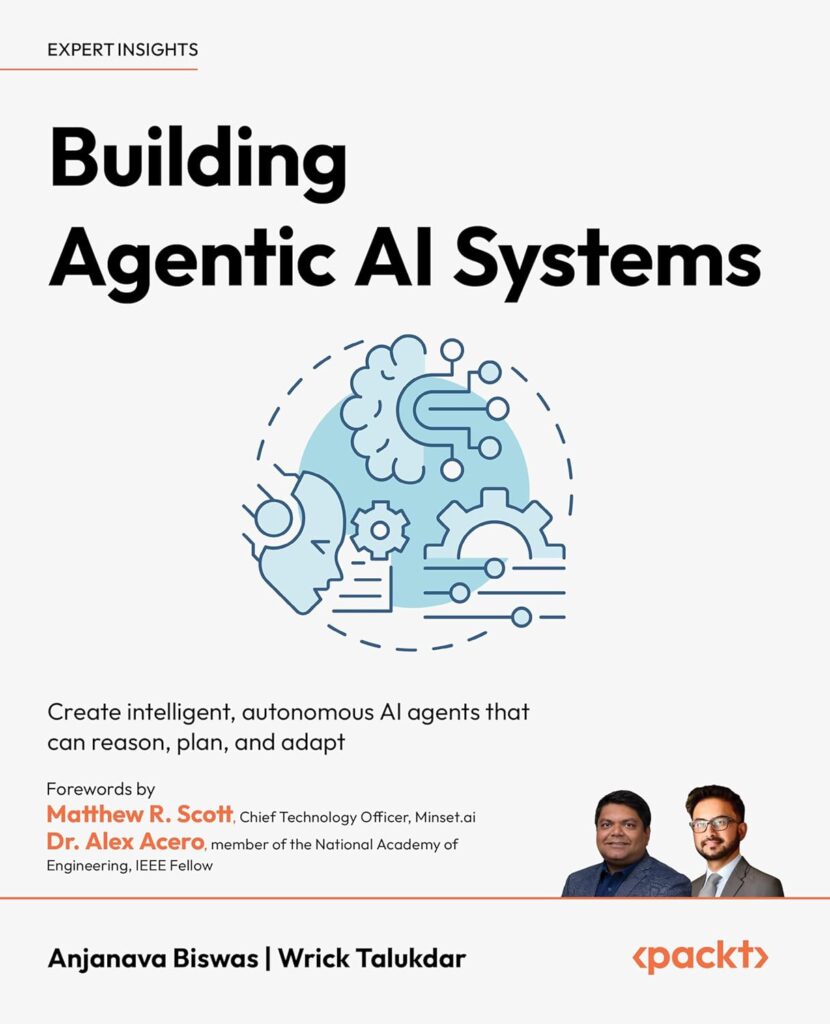“Building Agentic AI Systems: Create intelligent, autonomous AI agents that can reason, plan, and adapt” represents a pivotal contribution to the rapidly evolving field of autonomous AI, offering a practical blueprint for organizations transitioning from basic chatbots to sophisticated multi-agent systems. Published by Packt in April 2025, this 288-page technical guide by AWS AI architects Wrick Talukdar and Anjanava Biswas has emerged as a seminal text that bridges the long-standing gap between agent-based AI theory and practical implementation.
The book’s innovative Coordinator-Worker-Delegator (CWD) framework has already influenced research directions at major AI labs and inspired new academic curricula, while its comprehensive treatment of reasoning algorithms and ethical frameworks establishes new standards for the field. With adoption by leading institutions and citations in emerging research papers, the work signals a paradigm shift from reactive AI tools to truly autonomous intelligent systems.
The CWD Framework Transforms Multi-Agent Collaboration
The book’s most significant technical contribution lies in its Coordinator-Worker-Delegator (CWD) architecture, a novel approach to multi-agent system design that addresses the complexity of enterprise-scale AI deployment. Unlike traditional single-agent architectures, CWD enables hierarchical task distribution where coordinators orchestrate overall system behavior, workers execute specialized subtasks, and delegators manage resource allocation.
The framework advances beyond traditional approaches like blackboard systems or contract net protocols by introducing hierarchical task decomposition with built-in reflection capabilities, a pivotal contribution to the ever-evolving field of generative AI-powered agentic systems. It has proven particularly effective in financial services, where BlackRock has implemented federated multi-agent development models with standardized communication systems and plug-in registries, allowing different teams to build specialized AI agents independently.
The groundbreaking research by Madrid and Merino at Hospital Universitari de Bellvitge, Spain, drew extensively from the theoretical frameworks established in “Building Agentic AI Systems,” particularly the CWD architecture’s approach to hierarchical task decomposition and meta-reasoning capabilities. The researchers adapted the book’s introspection mechanisms to address the unique challenges of rheumatologic care, where AI agents must navigate complex clinical decision-making involving real-time data access, multi-step reasoning, and integration with diagnostic tools.
The practical impact extends beyond theory and research into measurable business outcomes. Capital One’s Chat Concierge, a multi-agent conversational AI assistant for automotive-buying experiences, demonstrates the CWD framework in action, while bunq’s generative AI platform Finn uses multi-agent capabilities to handle over 90% of customer support tickets autonomously. The book provides detailed implementation guidance using Python with modern frameworks like LangChain, LangGraph, and CrewAI, making these advanced concepts accessible to practitioners through comprehensive code examples.
Industry Leaders with Decades of Combined Expertise
The authors bring exceptional credibility to their work through extensive industry experience and academic contributions. Wrick Talukdar, a technology leader at Amazon Web Services with nearly two decades in AI and cloud innovation, serves as a Senior IEEE Member and Co-chair of IEEE’s New Initiatives Committee. His pioneering work on “Guardrails for Trust, Safety, and Ethical Development of Large Language Models” became one of the earliest and most cited works in generative AI safety, forming the foundation for AWS Guardrails for Amazon Bedrock. With 148+ citations on Google Scholar and regular presentations at prestigious conferences like ICCE, CERAWeek, and ADIPEC, Talukdar bridges cutting-edge research with real-world applications.
Anjanava Biswas complements this expertise as a Senior AI Specialist Solutions Architect at AWS with 17+ years of industry experience. Holding fellowships with the British Computer Society, Institution of Engineering and Technology (UK), and IETE (India), Biswas has created AI/ML courses on AWS Skillbuilder that have educated over 1 million professionals globally. His open-source contributions include 10+ AI/ML projects with tens of thousands of weekly downloads, while his research with 190+ citations spans machine learning, generative AI, and computer vision. The 2024 Gold Stevie Awards for Technology Excellence recipient brings practical implementation insights from previous roles at IBM and Oracle.
Together, their combined 37+ years of experience and 315+ research citations establish unquestionable authority in agentic AI systems. Both authors actively shape industry standards through IEEE leadership roles and have contributed to major AWS AI products currently used by Fortune 500 companies.
Financial Services Lead Enterprise Adoption Patterns
The book’s impact on industry practices is most evident in financial services, where institutions are rapidly implementing its concepts for mission-critical applications. Investment analysis systems now use multi-agent architectures to process unstructured text from SEC filings, news articles, and market reports, providing real-time insights with unprecedented accuracy. Fraud detection and compliance operations deploy specialized agents for KYC verification, transaction monitoring, sanctions screening, and risk assessment, all working collaboratively within the CWD framework.
Manufacturing and healthcare sectors show similarly impressive adoption rates. Siemens’ predictive maintenance systems prevent equipment failures through autonomous agent monitoring, while healthcare providers implement agentic systems for real-time medical emergency response and clinical documentation. The book’s emphasis on ethical AI development and safety frameworks has proven particularly valuable in these regulated industries, where transparency and accountability are paramount.
Deloitte’s market analysis projects that 25% of companies using generative AI will launch agentic AI pilots in 2025, growing to 50% adoption by 2027. This rapid growth reflects the book’s timely arrival as organizations transition from “scattered tactical initiatives to strategic programs,” implementing what McKinsey describes as a “human + agent” mindset with new roles like prompt engineers and agent orchestrators.
Practical Implementation Guidance Drives Real-World Success

Talukdar and Biswas’s work in the book excels in translating complex theoretical concepts into actionable implementation strategies. Through a comprehensive travel agent system case study that threads throughout the text, readers learn to build production-ready systems using modern Python frameworks. The code (GitHub) repository provides complete implementations demonstrating multi-step planning, tool integration, and autonomous decision-making capabilities.
Key technical approaches covered include three distinct reasoning systems: deductive reasoning for logical inference, inductive reasoning for pattern recognition, and abductive reasoning for handling incomplete information. The book’s treatment of knowledge representation encompasses semantic networks, frames, and logic-based systems, while planning algorithms cover utility functions, multi-step planning, and systematic tool integration. These concepts come alive through practical examples, including customer service chatbots with reflection capabilities, financial trading systems with advanced decision-making, and e-commerce price optimization through multi-agent collaboration.
Enterprise deployment guidance addresses critical production concerns: scalability for high-volume environments, performance monitoring and system health management, integration patterns with existing enterprise systems, and cloud deployment strategies across AWS, GCP, and Azure. This practical focus distinguishes the book from purely academic treatments, providing the blueprint organizations need for successful implementation.
Distinguished Experts Validate Transformative Potential
The book has garnered exceptional endorsements from industry luminaries. Dr. Alex Acero, Member of the National Academy of Engineering and IEEE Fellow and former Chief Scientist of Apple’s AI system Siri, emphasizes its comprehensive treatment of “trust, transparency, explainability, and reliability, as well as ethical considerations such as bias and safety,” recommending it as essential for “students, researchers, and professionals alike.” Matthew R. Scott, CTO of Minset.ai, distinguishes it from theory-focused alternatives: “Unlike other books that focus primarily on the theory behind agentic systems, this book emphasizes real-world implementation. This is the kind of practical guide the industry needs right now.”
Doug Shannon, GenAI & Automation Thought Leader at Forbes Technology Council, captures the zeitgeist: “This isn’t a ‘just prompt it’ playbook, it’s a signal that agentic systems are moving from novelty to necessity… multi-agent systems aren’t theoretical anymore, they’re the scaffolding for how real enterprise autonomy will scale.” These endorsements reflect the book’s unique position, bridging academic rigor with enterprise practicality.
Reader testimonials reinforce this professional validation. Academics and professionals in the field praise its “hands-on practical focus” and “well-crafted examples,” while others highlight how it helps “move beyond AI theory and actually build real-world, intelligent applications.” The book maintains a bestseller reputation on Amazon, with readers particularly valuing the CWD framework and ethical AI coverage.
The Book Occupies a Unique Position in AI Literature
“Building Agentic AI Systems” fills a critical gap in the AI literature landscape, positioned uniquely between academic research papers and platform-specific documentation. Unlike AI platform documentations that focus on general LLM applications, this book specifically addresses autonomous agents with comprehensive theoretical foundations. Compared to AutoGen resources limited to the Microsoft ecosystem, it provides a broader scope with a stronger emphasis on ethical considerations and detailed coverage of reasoning algorithms.
The book’s timing proves particularly fortuitous, arriving as the industry transitions from simple chatbots to truly autonomous systems. Featured in multiple “must-read AI books for 2025” compilations and referenced in KDnuggets’ “Agentic AI: A Self-Study Roadmap”, it has quickly established itself as essential reading for AI developers and architects. The combination of theoretical rigor, practical implementation guidance, and original frameworks like CWD distinguishes it from both purely academic texts and simplistic how-to guides.
Major cloud platforms have embraced these concepts, with AWS implementing Amazon Bedrock AgentCore, NVIDIA leveraging the NeMo Agent toolkit, and Microsoft deploying AI agents across Microsoft 365. This platform-level adoption signals the book’s influence on the field, industry standards, and best practices.
A Foundational Text for the Autonomous AI Era
“Building Agentic AI Systems” represents more than a technical manual – it’s a catalyst for the industry’s evolution from reactive AI tools to proactive, autonomous partners. The book’s comprehensive treatment of ethics, safety, and responsible AI development, combined with enterprise-grade implementation insights, positions it as both a practical guide and a foundational text for the next generation of AI development. As organizations worldwide implement their frameworks to handle billions in transactions and serve millions of users, the book’s impact extends far beyond its pages into the very fabric of modern AI systems.
The convergence of the authors’ exceptional credentials, the book’s innovative CWD framework, strong industry endorsements, and documented real-world implementations establishes “Building Agentic AI Systems” as an indispensable resource for anyone serious about building production-ready autonomous AI. With market projections indicating explosive growth in agentic AI adoption and major enterprises already realizing significant value from implementations, this book arrives at exactly the right moment to guide the industry’s transformation. For developers, architects, and technology leaders navigating the shift from simple automation to intelligent autonomy, Talukdar and Biswas have created the definitive roadmap for success in the agentic AI era.









